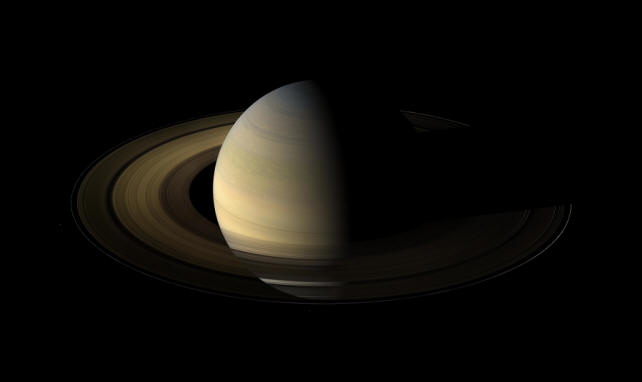|
|
|

Saturnian equinox. Note the extremely
narrow ring shadow. Credit: NASA/JPL/Space
Science Institute.
Spring Has Sprung
Apr
26, 2010
Saturn has started this new
season with some surprises.
On August 11, 2009, Saturn's rings
turned edge-on to the Sun, something
that happens once every 15 years as
Saturn revolves. When the rings
cross the equatorial plane, they
cool down considerably—dropping
more than 50 Kelvin in the last five
years.
Many things about Saturn have
changed in the 29 years since the
two Voyager spacecraft passed by the
giant gas planet. Saturn's
magnetosphere grew larger by more
than a million kilometers and then
contracted, only to begin expanding
again. The spokes in Saturn's B ring
disappeared and then reappeared. The
equatorial thunderstorm (known as
the Dragon Storm) that raged
continuously broke up, moved toward
the poles, and then erupted again a
short while ago in the lower
latitudes.
The most likely explanation for the
storms on Saturn is that they are
equivalent to sunspots. As the Sun
changes its behavior over the course
of a 22 year cycle, the electrical
output that connects it with its
family of planets varies. If
Saturn's Great White Spots, Dragon
Storm, and ring spokes are driven by
the same galactic Birkeland currents
that drive the Sun, they should get
stronger and closer to the equator
as the sunspot cycle oscillates. It
appears that that is just what has
happened over the past three
decades.
It is significant that the increases
to the energetic phenomena on Saturn
are occurring irrespective of
whether the sunspot cycle is at
maximum or minimum: the Sun is
exhibiting large-scale electrical
effects although it has just passed
solar minimum. It was suggested in a
previous Picture of the Day that it
is the change in magnetic
orientation that could be the key,
rather than the strength of the
solar magnetic field.
In 2008, scientists from the Max
Planck Institute discovered
partial rings around the gas
planet in a nearly invisible
collection of small arc segments.
Using the Cassini-Equinox
magnetospheric sensors, the team
found two areas near Saturn where
highly energetic electrons suddenly
drop out, presumably because
something is absorbing them.
The magnetospheric imager detected
lower energy emissions from the ion
torus that surrounds Saturn when the
ring arc segments are oriented
between Cassini and the electron
flow. The region of absorption is
almost 3000 kilometers wide, so
Cassini mission analysts speculate
that there could be unseen rings in
several bands.
The invisible rings are most likely
another manifestation of the
electrical environment that exists
near Saturn. What Cassini is
detecting most likely supports the
charged particle stream hypothesis
originally proposed by Kristian
Birkeland in 1913. He wrote: "It
seems almost incredible that such a
ring of cosmic dust should be able
to exist for ever, so to speak,
without other governing forces than
gravitation..."
Seen from our planet, the view of
Saturn's rings during equinox makes
them invisible. However, Cassini is
in orbit around Saturn 20 degrees
above the ring plane. As NASA puts
it, that "novel illumination
geometry" causes objects above the
rings to cast shadows across them.
Cassini photographed the shadows
from several of Saturn's moons, but
also saw
the shadows cast by something
new:
vertical structures embedded in
the rings.
Planetary scientists already knew
about material sticking out of the
rings in a few places, but until
Saturn reached its equinox it was
not possible to measure how high
these "ridges"
are. Saturn's main rings are
approximately 140,000 kilometers
wide, but were only thought to be
between 10 and 30 meters thick until
the discovery of the vertical
"walls" extending along the edges of
some rings. Some of the other newly
found formations are ripples over
four kilometers high.
How did these strange
clumps, undulations, and ridges
form? According to theories
presently under consideration, it is
collisions and shock waves that were
and are the culprits. The
gravitational attraction of
so-called "shepherd moons" is also
said to be responsible.
As some moons, such as Daphnis, move
up and down through the ring plane,
they do disturb the motion of the
ring particles. However, as was
discussed in
another Picture of the Day
article, Saturn's rings and moons
are electrically charged objects
moving within its vast
plasmasphere. The instabilities
inherent in that system most likely
contribute to the formation of
unusual features.
As shepherd moons pass close to the
rings, their effect is not like a
turbulent wind, which would be
expected when a gravitational
field's torque effects act on a
cloud of fine particles. Instead,
sine waves, perpendicular "braids,"
and cylindrical arcs are seen. Some
are multiply woven, like those in
the remote F-ring.
More data needs to be recovered, but
Cassini continues to provide an
embarrassment of riches for Electric
Universe advocates, and a box of
puzzles that consensus opinions
cannot assemble.
Stephen Smith
|
|
|
|
|
|
|
|
|
YouTube video, first glimpses of Episode Two in the "Symbols of an Alien Sky"
series.
|
|
|
|
|
|
|
Three ebooks in the Universe Electric series are
now available. Consistently
praised for easily understandable text and exquisite graphics.
|
|
|
|
|
|
|
|
|
|







